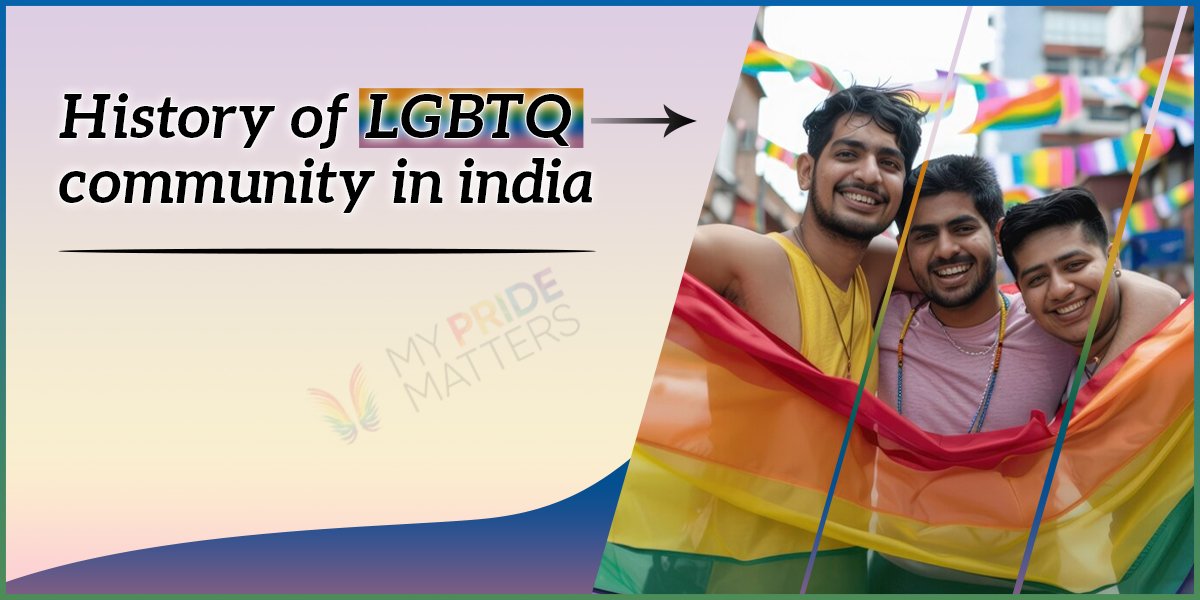RELATED BLOGS
Present posts in a best way to highlight interesting moments of your blog.

It’s been a rocky and challenging road for the LGBTQ+ community throughout history to get the acceptance today! The Pride community has experienced a remarkable journey of resilience as the cultural, social, and legal landscapes have changed, especially in the last few years. Let’s explore the history of LGBTQ+ in India, following its origins from prehistoric times through colonial oppression to the present-day fight for acceptance and rights.
In context with the LGBTQ India history, it appears from the old Indian texts and mythology that there was a time when different sexual identities were not only accepted but also cherished. Hindu mythology contains tales of same-sex unions and gender-neutral identities.
For instance, the god Ardhanarishvara, a cross between Lord Shiva and Goddess Parvati, represents the merger of masculine and feminine powers. In the epic Mahabharata, Shikhandi—who was first believed to be a woman but was later identified as a man—also had a major role in the Kurukshetra fight.
During the British colonial era, the LGBTQ+ community's struggle in India took a darker turn. Section 377 of the Indian Penal Code was introduced by the British in 1861, making "unnatural offences" illegal. With its emphasis on Victorian morality, this law singled out homosexual behaviour and declared it "against the order of nature."
The LGBTQ+ community was marginalised for more than a century due to the oppressive atmosphere that the colonial mindset created against same-sex family sociology and orientation.
The LGBTQ+ community remained mostly hidden after India attained independence in 1947 since Section 377 was still in effect. Social views were still predominantly conservative, and homosexuality was seen as forbidden. Queer identities were frequently marginalised in society, and the LGBTQ+ community experienced pervasive discrimination. The underground community, on the other hand, kept expanding and provided networks of support for people unable to publicly declare who they were.
LGBTQ+ representation continued to exist in Indian literature, art, and film, even in the face of social restrictions. Social standards around same-sex partnerships were challenged by films such as Fire (1996) and My Brother Nikhil (2005). Despite their smallness, these cultural changes prepared the stage for later activity.
The growth of homosexual rights activism in the 1990s marked a turning point for the LGBTQ India history. Many organisations started promoting LGBTQ+ rights, concentrating on topics like social justice, health, and decriminalising homosexuality. One such organisation is the Humsafar Trust in Mumbai.
This triumph, though, was fleeting. The Indian Supreme Court upheld Section 377 in 2013, declaring that the legislature, not the courts, was in charge of changing the legislation. Although the verdict represented a major setback for the LGBTQ India history, it also inspired supporters and campaigners to further up their campaigns for equality.
On September 6, 2018, the Supreme Court of India ruled in a momentous decision to abolish Section 377, decriminalising homosexuality. The LGBTQ+ community's liberty, privacy, and dignity were upheld by the five-judge bench's decision to end the criminalisation of consenting same-sex relationships. As Chief Justice Dipak Misra pronounced the verdict, he added, "History owes an apology to the LGBTQ community for the delay in ensuring their rights."
Even though the 2018 decision represented a major legal win, the LGBTQ+ community and challenges faced by LGBTQ youth still are by and large. Persistent deep-seated biases are still present, especially in conservative and rural areas of society. It is still common for there to be homophobia and transphobia, and LGBTQ+ people frequently face discrimination in the workplace, in housing, in the medical community, and in schools. Adoption rights and same-sex marriages are still not legally recognised, which is recognized a serious problem in the present and history of pride in India.
Throughout the history of LGBTQ in India, community itself and allies have persevered Pride community through many hardships and made great progress towards acceptance and inclusion.
My Pride Matters is dedicated to commemorating India's rich history and current fight for equality as an ally of the LGBTQ+ community. We are committed to commemorating this journey by offering unique Pride apparels and pride gifts that represents acceptance, diversity, and love.
Show your support for the community by taking important acts and wearing our eye-catching Pride Wear unisex tops to show off your solidarity. Let's continue to strive for a society that is inclusive, loving, and equitable by working together to promote awareness.